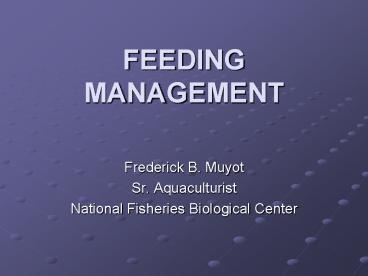FEEDING MANAGEMENT - PowerPoint PPT Presentation
1 / 16
Title:
FEEDING MANAGEMENT
Description:
FEEDING MANAGEMENT Frederick B. Muyot Sr. Aquaculturist National Fisheries Biological Center FEEDING MANAGEMENT One of the important aspects in the breeding and ... – PowerPoint PPT presentation
Number of Views:712
Avg rating:3.0/5.0
Title: FEEDING MANAGEMENT
1
FEEDING MANAGEMENT
- Frederick B. Muyot
- Sr. Aquaculturist
- National Fisheries Biological Center
2
FEEDING MANAGEMENT
- One of the important aspects in the breeding and
culture of fishes - In aquaculture, comprise of about 40-60 of
production cost - Feeds must be cost-effective and efficient
3
Categories of fishes based on food preference
- Herbivore - prefers food which are plant-based
- Carnivore - eats other aquatic animals
- Omnivore - eats both plant and animal-based foods
- Few ornamental species are categorized as
strictly carnivores or herbivores - Most are omnivores
4
Food Habits
- Grazers nibble at plants or pick at small
plankton or benthic animals - Filter feeders feeds on planktonic plants and
animals by straining concentrations of planktons - Bottom feeders or scavengers plant animal
debris (detritus) - Predator preys on other aquatic animals
5
Feed Types
- Fresh live foods live animals given as feeds
(Artemia, Daphnia, Moina, bloodworms) - Frozen foods animal or plant matter given as
foods and stored in freezer (meats of fish,
squid, beef heart, spinach) - Dried or Freeze-dried foods available in
petshops or markets (dried alamang, krill, water
fleas and freeze-dried plankton) - Artificial feeds flakes, mash, crumbled, pellets
6
Factors Affecting Feeding Activity of Fish
- Type of food given
- Feed composition and quality
- Water quality
- Stocking density
- Presence of competitors
- Diseases
7
Basic Food Elements Needed by Fish
- Protein provides energy and builds body tissues
- amino acids
- Carbohydrates source of energy
- starch, glucose, fructose, fiber
- Fats also energy foods reserved energy
- fatty acids
- Vitamins assist in metabolic process in the
body - oil soluble vitamins A, D, E, K
- water soluble vitamins B, C, panthothenic acid,
niacine, folic acid and others - Minerals regulate fish activities theie
physical structure - phosphorus, calcium, copper, iron, magnesium,
manganese and others
8
(No Transcript)
9
Feeding the Fish
- Generally, fish consumes about 4-5 of their body
weight - In ponds where there is natural food present,
fish could grow at a certain population density
even without supplemental food - Fish must be given 2-4 of their body weight
10
Computing for amount of feeds to be given
- Amount of feed per day
- no. of fishes x ave. body weight of fish x
feeding rate (e.g. 4) - Example You have 1,000 goldfish with an average
weight of 10g, and you will feed 4 of body
weight per day - Amount of feed per day 1,000 pcs x 10 g/pc x
0.04 - 400 g feeds per day
- If feeding is twice a day, divide amount by 2
- 400 g/2
- 200 g per feeding
11
Feeding Management
- Feeding is done at least twice a day
- For small fishes (live-bearers), feeding can be
done based on demand (at satiation level) - Artificial feeds such as finfish feeds, prawn
feeds or combination of rice bran fish meal
(20-30 fish meal, 80-70 rice bran) commonly
used as feeds - Broodstock given high protein foods
- Larvae or fry given tiny live foods (infusoria,
Artemia, Moina) - Juveniles could be given commercial feeds
12
Feeding Management
- Feeding is done gradually, making sure all fish
have eaten - Feeds must be evenly distributed to the grow-out
areas - Avoid wastage of feeds
13
Feeding Practice at NFBC
- Breeders
- Live-bearers prawn feeds (PO2) at satiation
level - Goldfish, Koi tilapia or bangus grower feeds
(floating feeds preferred) alternated with prawn
grower feeds at 2-4 feeding rate - Angelfish prawn feeds starter crumble (PO2) at
satiation level - Fighting fish mosquito larvae or prawn feeds
starter crumble at satiation level
14
Feeding Practice at NFBC
- Breeders
- Red pacu, hammerhead, tinfoil barb, rainbow shark
(fishes for induced breeding) tilapia or bangus
grower feeds during non-breeding season and
grouper or prawn grower feeds 3 months before and
during breeding season at 3-4 feeding rate - Cichlid mouthbrooders (blue kenai, auratis, 14-K,
ice blue) tilapia or bangus crumble feeds
alternated with prawn feeds at 2-4 feeding rate - Flowerhorn flowerhorn feeds
15
Feeding Practice at NFBC
- Breeders
- Gourami tilapia or bangus crumble feeds
alternated with prawn feeds starter crumble at
2-4 body weight - Larval Rearing
- Live-bearers powdered prawn feeds at satiation
level - Goldfish, Koi, angelfish, flowerhorn, cichlid
mouthbrooders, induced fishes Artemia nauplii
for 5-10 days - Fighting fish, gourami infusoria for 2-3 days,
then Artemia for 5-7 days
16
Feeding Practice at NFBC
- Nursery rearing and grow-out
- Live-bearers powdered prawn starter feeds,
tilapia or bangus fry mash at satiation level
until harvest - Goldfish, koi, angelfish, flowerhorn, cichlid
mouthbrooders, induced fishes fry mash for
small fishes, crumbled feeds for juveniles and
grower pellets for larger sizes at 2-4 feeding
rate - Fighting fish, gourami powdered prawn feeds for
small fishes prawn crumble feeds for juveniles
until harvest at 2-4 feeding rate































